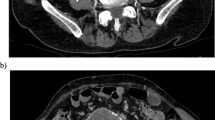Abstract
We report the case of a 74-year-old man who developed type IA endoleak after endovascular thoracic aortic repair. The patient was admitted with expansion of the aneurysm after TEVAR, for additional therapy. Fluoroscopy and cone-beam computed tomography-guided direct transthoracic sac puncture and complete embolization of the endoleak channels with metal coils and glue were performed, and resulted in complete exclusion of the endoleak. One month after the coil embolization, the type IA endoleak was completely excluded, and the thoracic aneurysm had decreased in size.



Similar content being viewed by others
References
Conrad MF, Ergul EA, Patel VI, Paruchuri V, Kwolek CJ, Cambria RP. Management of diseases of the descending thoracic aorta in the endovascular era: a medicare population study. Ann Surg. 2010;252:603–10.
Orandi BJ, Dimick JB, Deeb GM, Patel HJ, Upchrch GR Jr. A population-based analysis of endovascular versus open thoracic aneurysm repair. J Vasc Surg. 2009;49:1112–6.
Stavropoulos SW, Carpenter JP. Postoperative imaging surveillance and endoleak management after endovascular repair of thoracic aortic aneurysms. J Vasc Surg. 2006;43:89A–93A.
Morales JP, Greenberg RK, Lu Q, Cury M, Hernandez AV, Mohabbat W, et al. Endoleaks following endovascular repair of thoracic aortic aneurysm: etiology and outcomes. J Endovasc Ther. 2008;15:631–8.
Parmer SS, Carpenter JP, Stavropoulos SW, Fairman RM, Pochettino A, Woo EY, et al. Endoleaks after endovascular repair of thoracic aortic aneurysms. J Vasc Surg. 2006;44:447–52.
Alsac JM, Khantalin I, Julia P, Achouh P, Farahmand P, Capdevila C, Isselmou KO, et al. The significance of endoleaks in thoracic endovascular aneurysm repair. Ann Vasc Surg. 2011;25:345–51.
Adams JD, Tracci MC, Sabri S, Cherry KJ, Angle JF, Matsumoto AH, et al. Real-world experience with type I endoleaks after endovascular repair of the thoracic aorta. Am Surg. 2010;76:599–605.
Desai S, Nemcek AA. Percutaneous biopsy. In: Mauro MA, Murphy KP, Thomson KR, et al., editors. Image-guided interventions. 1st ed. Philadelphia: Saunders Elsevier; 2008. p. 1339–44.
Baum RA, Carpenter JP, Cope C, Golden MA, Velazquez OC, Neschis DG, et al. Aneurysm sac pressure measurements after endovascular repair of abdominal aortic aneurysms. J Vasc Surg. 2001;33:32–41.
Stavropoulos SW, Tucker J, Carpenter JP. Thoracic endoleak embolization using a direct percutaneous puncture of the endoleak through lung parenchyma. J Vasc Interv Radiol. 2009;20:1248–51.
Riesenman PJ, Farber MA, Mauro MA, Selzman CH, Feins RH. Aortoesophageal fistula after thoracic endovascular aortic repair and transthoracic embolization. J Vasc Surg. 2007;46:789–91.
Katada Y, Kondo S, Takahashi S, Okita Y, Kagoshima A, Rokkaku K, et al. Direct percutaneous puncture embolization of type II endoleaks using coaxial technique. J Endovasc Ther. 2013;20:34–8.
Klein S, Picus D. Thoracic type II endoleak embolization using direct percutaneous puncture. Cardiovasc Intervent Radiol. 2012;35:1249–52.
Mussa FF, Maldonado TS, Schwartz CF. Percutaneous embolization of patient intercostal artery causing persistent type II endoleak and sac enlargement of thoracoabdominal aneurysm 2 years after hybrid repair. J Thorac Cardiovasc Surg. 2012;144:e102–6.
Kreusch AS, Samuels S, Benenati JF, Schernthaner M, Uthoff H. Direct percutaneous sac injection for treatment of a thoracic type II endoleak. J Vasc Interv Radiol. 2013;24:1071–3.
Conflict of interest
The authors declare that they have no conflict of interest. The authors have no commercial, proprietary, or financial interest in any products or companies described in this article.
Author information
Authors and Affiliations
Corresponding author
About this article
Cite this article
Katada, Y., Kondo, S., Tsuboi, E. et al. Type IA endoleak embolization after TEVAR via direct transthoracic puncture. Jpn J Radiol 33, 169–172 (2015). https://doi.org/10.1007/s11604-015-0392-7
Received:
Accepted:
Published:
Issue Date:
DOI: https://doi.org/10.1007/s11604-015-0392-7




